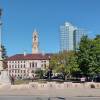Mother nature wasn't the only one producing snow Friday morning, as this week's low temperatures have allowed ski resorts in the area to start making their first snow of the season, too. That they can, is thanks in part to the work of a General Electric scientist — and his auspicious experiment in the clouds over the Berkshires.
It wasn’t all that unusual that a plane was flying over Mount Greylock in the Berkshires on Nov. 13, 1946. And it wasn’t really noteworthy that is was snowing. What was remarkable is that a man in the plane made it snow.
"We put about six pounds of dry ice into this four-mile cloud, and within a very few minutes saw long streamers of snow falling from the base of the cloud," said scientist Vincent Schaeffer, explaining his snow-making breakthrough in a 1947 GE promotional film. Schaeffer’s snow evaporated before it reached the ground this time, but the science was sound. Mother nature had been hacked.
"Under many conditions of course, full-fledged snowstorms will be produced in this way," Schaeffer said in the film.
Well … not quite. As news of Schaeffer’s innovation spread, so too did the pushback. Concerns ranged form the political to the ethical. In the Boston Globe that week, a headline read simply “Let Nature Be.” But for ski resort operators, Schaeffer had shown them the future. It was bright, and it was white. Within a few years, others brought Schaeffer’s science down from the clouds. By 1950, ski resorts across the country were making snow by compressing air and firing water droplets into the freezing skies.
"It’s just amazing how far snowmaking has come from there," said Jeff Crowley, president of Wachusett Ski Resort. "It used to be that they’d be lucky if they could make 15 inches of snow on a small area, but now the guys can make two feet of snow over acres of terrain – and in much quicker time."
Snowmaking today is one of the most expensive — and crucial — aspects of operating a mountain. Almost 90 percent of American ski resorts make their own snow. Without it here, Crowley says bluntly, "We’d be out of business."
And the science continues to advance. The quality of man-made snow improves every year.
"I would challenge you to be able to determine what is machine-made snow and what is natural snow," Crowley said. "It’s phenomenal."
There are machines that can calculate the moisture and pressure in the air, guns mounted 40 feet in the air — all designed to maximize the output of each synthetic blizzard.
"Theoretically we don’t even need natural snow, all we need is cold weather," Crowley said.
That’s a crucial point. As far as snow making has come, Mother Nature still holds a trump card. You can’t make snow unless it’s freezing.
"Every now and then someone comes out with a gun that they claim can make snow above freezing," Crowley said. "That never happened in my lifetime."
Despite all the advances, making snow still takes a lot of energy — and water (100 million gallons each year at Wachusett alone). And with the planet warming, Crowley says that increasing efficiency isn’t just about raising the quality of the snow and lowering the cost — it’s also about shrinking their carbon footprint.
"We’re gonna be the first guys to really feel the brunt of a warmer planet," he said. "The industry has really taken some major progressive steps to doing everything in our power to try to reduce our energy consumption."
Man-made snow was first shown to be possible in the wild over Mount Greylock, right here in Massachusetts - 68 years ago this week.
Watch Schaefer demonstrate snow making:




